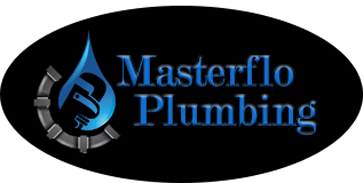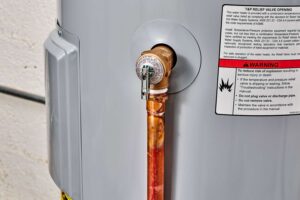To clear bathroom drain clogs, start by plunging the drain firmly with a plunger or using a drain snake to tackle deep blockages effectively. Consider natural remedies like baking soda and vinegar, which fizz and bubble to break down clogs. A hot water flush can also dissolve and wash away loosened debris. If you prefer manual cleaning, remove and clean the P-Trap, dislodging buildup with a wire brush. For tougher clogs, chemical drain cleaners can be effective but remember to wear protective gear. If you want to learn more top techniques to clear bathroom drain clogs, mastering these basics will set you on the right path.
Key Takeaways
- Plunge the drain with a strong seal for effective blockage removal.
- Use a drain snake for deep clogs inaccessible by other methods.
- Try natural remedies like baking soda and vinegar for eco-friendly solutions.
- Clean the P-Trap manually to dislodge and remove buildup.
- Consider professional plumbers for expert diagnosis and specialized tools for stubborn clogs.
Plunge the Drain
When facing a bathroom drain clog, grab a plunger and get ready to tackle the blockage head-on. Begin by ensuring there is enough water in the sink or tub to cover the bottom of the plunger. This water helps create a seal for effective plunging. Place the plunger over the drain and push it down firmly, then pull up sharply to create suction. Repeat this plunging motion several times, making sure to maintain a strong seal.
As you plunge, keep in mind that consistency is key. It may take several attempts before you start to see results. If the clog is stubborn, try adding some petroleum jelly to the rim of the plunger for a better seal. Remember to plunge with a steady rhythm to maximize the pressure on the clog.
After plunging, run some water to see if the clog has cleared. If the water drains smoothly, congratulations on successfully plunging the drain. If not, you may need to try alternative methods like using a drain snake.
Use a Drain Snake
To clear stubborn bathroom drain clogs effectively, consider utilizing a drain snake as a powerful tool for removing deep blockages. A drain snake, also known as a plumbing snake or auger, is a flexible tool that can reach deep into the pipes to dislodge and remove clogs that are causing drainage issues. Here are some tips for using a drain snake effectively:
- Insert the Drain Snake: Carefully insert the end of the drain snake into the drain opening until you feel resistance. This indicates that the snake has reached the clog.
- Rotate and Push: Rotate the handle of the drain snake while gently pushing it further into the drain. This motion helps the snake grab onto the clog and break it apart.
- Slowly Withdraw the Snake: Once you feel that the clog has been broken up, slowly withdraw the snake from the drain. Be prepared for some resistance as the snake pulls out the dislodged debris.
Try Baking Soda and Vinegar
For tackling bathroom drain clogs, consider employing the simple yet effective method of using baking soda and vinegar. This natural combination can help break down buildup and clear minor clogs without resorting to harsh chemicals. To start, pour about half a cup of baking soda down the drain, followed by half a cup of vinegar. You will notice fizzing and bubbling – this is normal and indicates that the solution is working to break down the blockage. Let the mixture sit in the drain for about 30 minutes to allow it enough time to work its magic. Afterward, flush the drain with hot water to wash away the loosened debris. This method is gentle on your pipes and the environment, making it a safe and eco-friendly option for regular maintenance. While it may not be as powerful as a drain snake for tougher clogs, baking soda and vinegar can be a handy solution for keeping your bathroom drains flowing smoothly.
Hot Water Flush
Consider following up the baking soda and vinegar method with a hot water flush to further clear any remaining debris in your bathroom drain. Hot water can help dissolve and wash away any loosened clogs, leaving your drain cleaner and freer flowing. Here's how you can effectively perform a hot water flush:
- Boil Water: Boil a pot or kettle of water on the stove or using an electric kettle until it reaches a rolling boil. Make sure there is enough water to flush down the drain effectively.
- Pour the Water: Carefully pour the hot water directly down the drain in a slow and steady stream. Be cautious not to splash yourself with the hot water.
- Repeat if Necessary: If the clog persists after the first hot water flush, you may need to repeat the process a couple of times to fully clear the drain. Patience and persistence can often lead to successful results without the need for harsh chemicals.
Remove and Clean the P-Trap
You can effectively clear bathroom drain clogs by removing and cleaning the P-Trap, a common location for debris buildup. The P-Trap is the U-shaped pipe located beneath the sink that traps water to prevent sewer gases from entering your home. Over time, this trap can accumulate hair, soap scum, and other debris, leading to clogs.
To clean the P-Trap, start by placing a bucket underneath to catch any water or debris that may come out. Loosen the slip nuts at both ends of the P-Trap using a pair of pliers or a wrench. Once the nuts are loose, carefully remove the trap and empty its contents into the bucket. You can use a wire brush or pipe cleaner to dislodge any stubborn buildup inside the trap. Rinse the P-Trap thoroughly with water before reattaching it.
Cleaning the P-Trap is a simple yet effective way to clear out clogs caused by debris accumulation. By performing this maintenance task regularly, you can help prevent future blockages and keep your bathroom drains flowing smoothly.
Enzyme-Based Drain Cleaner
To tackle persistent bathroom drain clogs beyond physical removal, consider using an enzyme-based drain cleaner that effectively breaks down organic matter. These cleaners contain bacteria that feed on the organic buildup inside your drains, helping to clear clogs without the need for harsh chemicals. Here are three key points to keep in mind when using enzyme-based drain cleaners:
- Wait Time: Enzyme-based drain cleaners work over time, so be patient and allow an adequate amount of time for the bacteria to break down the clog. Typically, you should leave the cleaner in the drain overnight for best results.
- Regular Use: To prevent future clogs, consider using enzyme-based drain cleaners on a regular basis as part of your maintenance routine. This can help keep your drains clear and prevent major blockages from forming.
- Environmental Impact: Enzyme-based cleaners are usually more environmentally friendly compared to chemical drain cleaners, making them a safer option for your home and the planet.
Boiling Water Method
For guaranteeing simple bathroom drain clogs quickly and effectively, one technique to consider is the Boiling Water Method. This straightforward approach can often be quite successful in dislodging minor clogs caused by substances like soap scum or grease. To implement this method, begin by heating a pot of water on the stove until it reaches a rolling boil. Once the water is boiling vigorously, carefully pour it directly down the clogged drain in a steady stream. The hot water can help break down the clog by melting away the substances causing the blockage. It's crucial to pour the water slowly to avoid splashing and to guarantee that it has enough time to work its way through the blockage. After pouring the boiling water, allow some time for it to work its magic before testing the drain to see if the clog has cleared. Remember to exercise caution when handling boiling water to prevent burns or injuries.
Wet/Dry Vacuum
Using a wet/dry vacuum is an effective method for clearing stubborn bathroom drain clogs. When traditional methods like plunging or using a drain snake have failed, a wet/dry vacuum can provide the extra power needed to dislodge the blockage and restore proper drainage in your bathroom sink or tub.
Here are three key steps to effectively use a wet/dry vacuum for clearing bathroom drain clogs:
- Prepare the vacuum: Make sure the vacuum is set to vacuum up liquids, remove any attachments, and create a tight seal around the drain opening.
- Create a seal: Position the nozzle directly over the drain to create a tight seal. You may need to use duct tape or a towel to ensure a proper seal.
- Powerful suction: Turn on the vacuum to its highest setting to generate strong suction. Let it run for several minutes to dislodge the clog effectively. Remember to check the vacuum bag or canister for any debris that was sucked up.
Chemical Drain Cleaner
When dealing with stubborn bathroom drain clogs, contemplate utilizing a chemical drain cleaner as a potential solution. Chemical drain cleaners are formulated to break down clogs caused by hair, soap scum, grease, and other organic materials. These cleaners typically contain strong chemicals such as sulfuric acid or sodium hydroxide, which work by generating heat to dissolve the clog.
To use a chemical drain cleaner, start by carefully following the instructions on the product label. Most cleaners require pouring the specified amount directly into the clogged drain, allowing it to sit for a certain period, and then flushing the drain with hot water. It is essential to wear protective gear like gloves and goggles when handling these products to prevent skin irritation or accidental splashes.
While chemical drain cleaners can be effective in clearing minor clogs, they may not work on more severe blockages or on certain types of pipes. If the clog persists after using a chemical cleaner, it may be time to contemplate other methods or seek professional help.
Call a Professional Plumber
Consider reaching out to a professional plumber to address persistent or complex bathroom drain clogs effectively. Plumbers have the expertise and tools to tackle even the most stubborn clogs that home remedies may not be able to manage. Here are three reasons why hiring a professional plumber can be the best solution for your bathroom drain issues:
- Professional Assessment: Plumbers can conduct a thorough evaluation of your drain system to identify the root cause of the clog. This guarantees that the problem is properly diagnosed and effectively resolved.
- Specialized Equipment: Professional plumbers have access to specialized tools and equipment designed to clear tough clogs efficiently. These tools can reach deep into the pipes to remove blockages without causing damage.
- Preventative Maintenance: By hiring a professional plumber, you can benefit from their expertise in preventing future clogs. They can provide recommendations on how to maintain your drains properly to avoid similar issues in the future.
Conclusion
Masterflo Plumbing is North Georgia's most trusted plumbing company. With over 20 years experience and staffed with master plumbers, our team is equipped and ready to serve your plumbing needs. From water heater repair or replacement to minor and major plumbing problems, you can count on Masterflo Plumbing for your plumbing needs throughout Cherokee county and metro Atlanta. Remember to always prioritize safety and follow proper instructions when attempting to clear a clog on your own. With a little bit of effort, you can have your bathroom drain running smoothly in no time.


